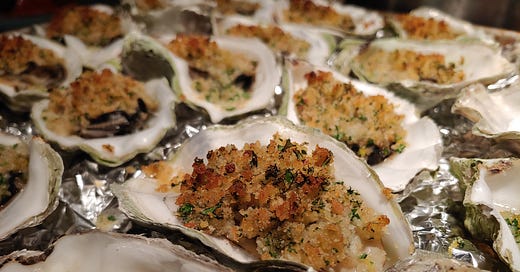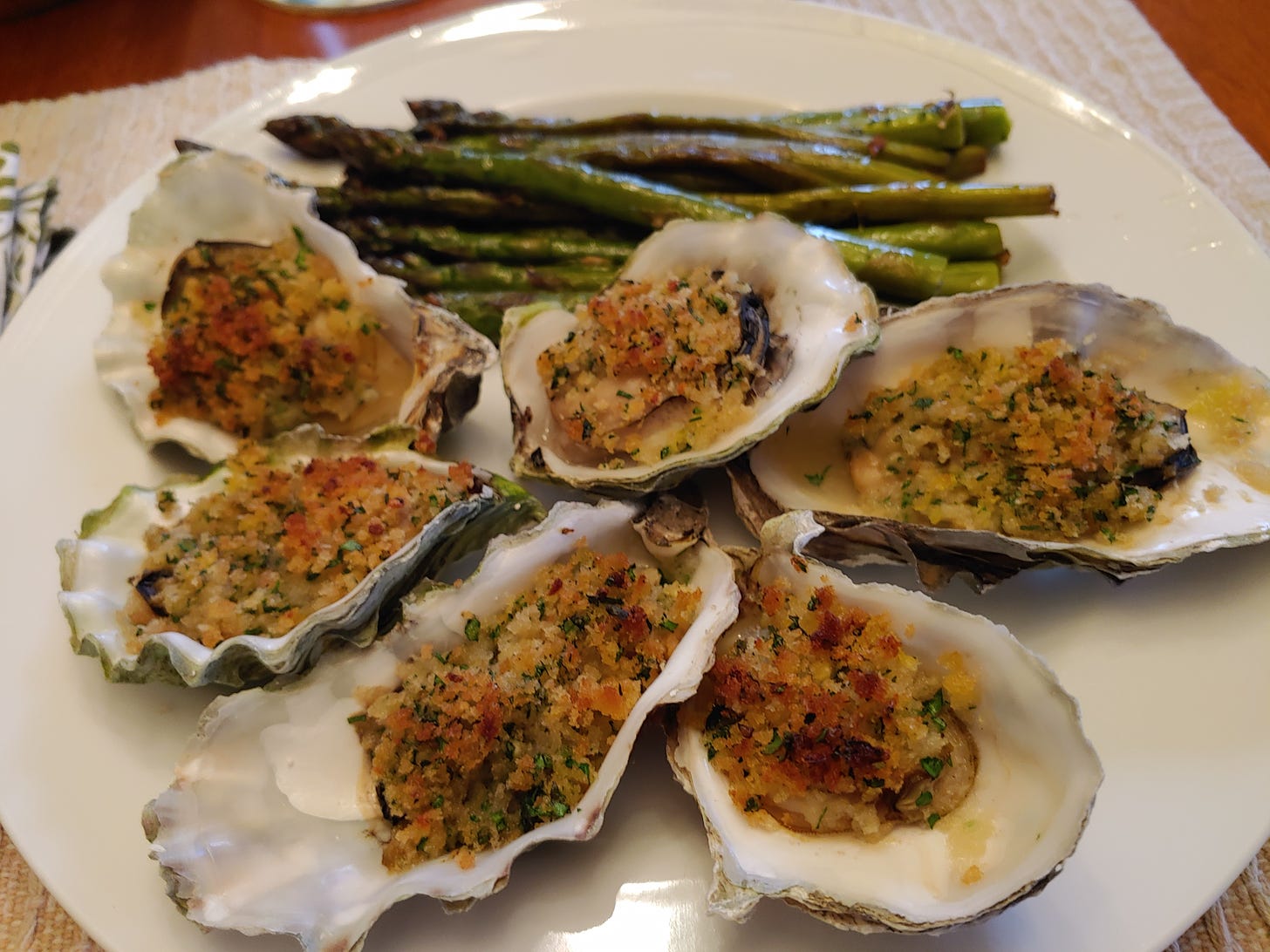Rambling on about Oysters
Contemplating why they're so compelling, an array of oystery links and Oysters Baked with Gremolata Bread Crumbs
First off, welcome to the bunch of new subscribers who joined over the past month or so. Thanks for coming to the seafood party!
To get a bit of engagement going—not just me sending out my monthly musings—I’d love to hear a couple things from all of you reading this issue. If you could drop down to comments and let me know one or all of the following: 1) your all-time favorite seafood, the one you could never grow tired of eating; 2) your favorite way to cook seafood at home; and 3) a particularly memorable seafood-at-its-source experience or seafoody highlight from a trip (my visit to Pinhais sardine cannery in Porto comes to mind, which I wrote about in this issue).
I look forward to reading some of your notes!
So…oysters
The introductory section of my cookbook on the topic is titled “What is it about oysters?” The book’s first paragraph goes on to say:
They inspire hip oyster bars, backyard grilling feasts, and elegant celebration meals. They evoke songs, poems, and fashion shows. They bring out our competitive streak to see who can shuck and slurp the most. They prompt pilgrimages to their home territory, which might include late-night forays to moonlit bays seeking the best of the season at its pinnacle of freshness. They satisfy our hunger, fuel our romance, and feed our souls. I’ve written quite a lot about Northwest foods over the years, and no other food seems to strike the kind of food-culture chord that oysters do.
Oysters capture our imaginations and attention for reasons cultural, culinary, artistic, ecological, adventurous, scientific, historical, convivial, and so many more. I could go on for pages trying to surmise why they draw such enthusiasm, and enthusiasm that’s expressed in so many different ways.
This is the seafood that, by far, I’ve been most deeply engaged with over the past decade or so. It began with researching and writing Oysters: Recipes that Bring Home at Taste of the Sea, which first came out in 2016 (re-released this December in paperback), though the topic had certainly come up among other seafood writing I’d done in years prior. It’s little surprise oysters have come up a number of times in this newsletter thus far. Among them are a few references to oyster festivals (including this issue recounting part of my first-time visit to the St. Mary’s County Oyster Festival in Maryland last year), the joys of a simple grilled oyster, and in this issue focused on travel I mention a couple oyster trails (in Maine and Virginia) to follow and oyster farms to visit. In fact, just today an email from Blue Island Oysters on New York’s Great South Bay announces that bookings are now open for their July oyster farm tour dates (which includes some kayaking too, sounds like). Ha!! I knew there was a good reason I waited until May 1 to send you April’s newsletter.
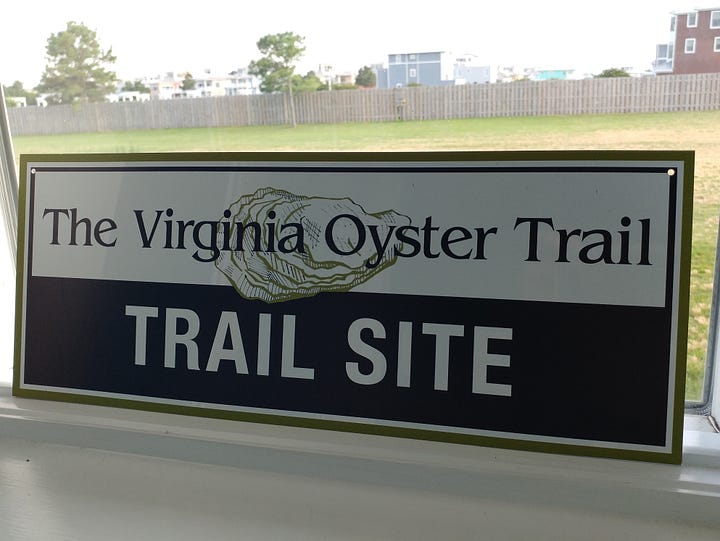
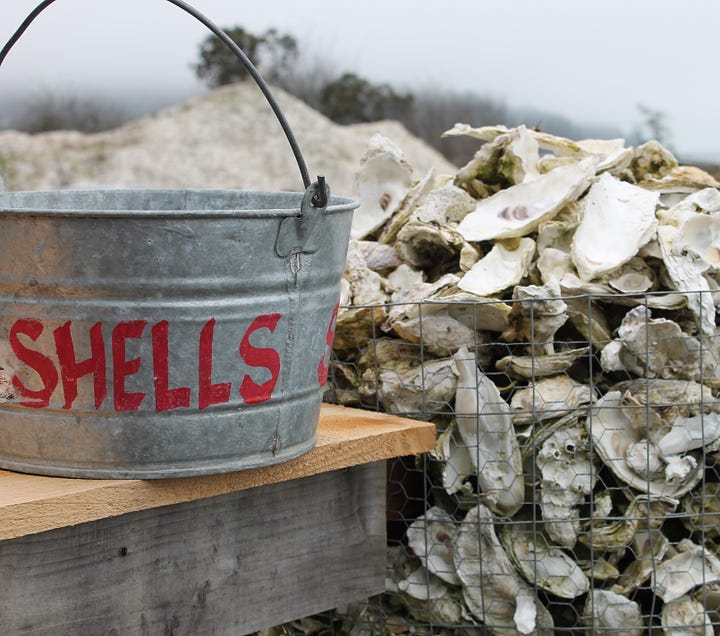
When folks like me have an oyster radar out, life gets to be delightfully distracting. I perk up when I see, for instance, that in the last episode of the latest season of Somebody Feed Phil, he goes from a visit to the Talisker distillery on Scotland’s Isle of Skye to a little place up the road called The Oyster Shed. There he’s shown the glories of replacing a bit of a half-shell oyster’s liquor with a splash of whisky, to slurp down with the oyster. (I’d come across the Scotch-and-oysters custom while researching ideal beverage pairings for Oysters, I would not have guessed that Scotch can pair so well with raw oysters. It was a really delicious surprise when I tried it.)
And menu selections can be quickly narrowed down, as they were when I took myself out to dinner at Nostrana a few nights ago. This longtime-favorite Portland restaurant has one of those everything-looks-good menus and it’s hard to believe I didn’t get a pizza, they’re outstanding here. This time, I was happily distracted by the Warm Smoked Oyster Dip among the starters. That with the fabulous Insalata Nostrana (all radicchio with a Caesar-style dressing and sage-rosemary croutons). And the perfect finale: a scoop of vanilla gelato with outstanding chocolate sauce. I’ve asked for more details about how they make the smoked oyster dip, may have more to share in a future issue. Very cheesy and delicious. That was an easy decision to make.
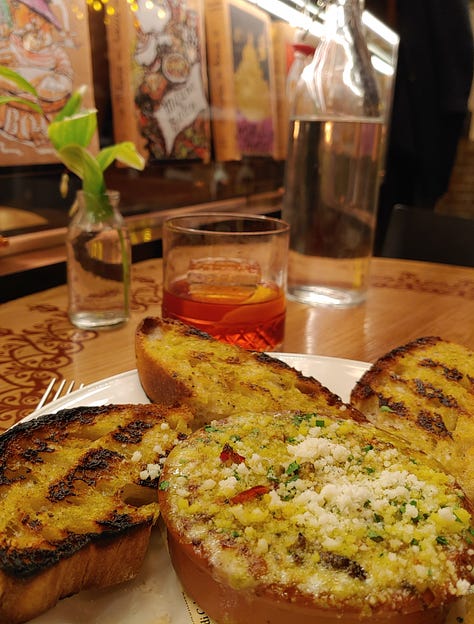


A variety of interesting oystery things to share
If the idea of tasting five different species of oyster sounds intriguing to you (not just different growing-regions, but species), get your order in and your shucking knife out! There are five species of oysters grown in the United States, two of which are native to US waters: Olympia oysters on the West Coast and Eastern oysters on the East Coast and Gulf Coast. The others are Pacific oysters and Kumamoto oysters that are transplants from Japan, and European flat oysters that came here from…Europe. It’s a rare treat to have an opportunity to taste all five at one sitting, one that Real Oyster Cult currently offers on their website, due to be available until the end of May. There is no better way to appreciate the distinct flavor/texture/other characteristics of different varieties of the same food (be that oysters, cheese, apples, strawberry jam) than to taste them side by side.
If you’re not already well practiced at the art of shucking oysters (which will come in handy for that species sampler above and for the baked oyster recipe below), this video from Hog Island Oysters based on Tomales Bay in California is a particularly good lesson.
If you’re very much a beginner, I think it’s even better to shuck with the oyster flat on the counter, using a kitchen towel to hold the oyster securely and help protect your oyster-holding hand (it can still be a good idea to have an oyster glove on your oyster-holding hand for extra protection). I haven’t yet found a video example of that version that I really like, so will get to it myself and share that before long.
And if you’re ever stuck on a desert island with a great source of oysters but no shucking knife, this otter at the Oregon Zoo shows how you can make do in the wild. Let’s just hope it never comes to that.
This New York Times article from a few weeks ago about a wintry outdoor oyster roast was one of those dreamy pieces to read through, exhibiting a style of entertaining that looks so relaxed, casual, just a bunch of friends getting together, pooling their resources and talents to put on a great meal. At least speaking for myself, I know that my version—while as delicious as intended—might not come across as quite so stylish. I'm totally behind the celebration of cooking seafood outdoors, and particularly love the embrace of doing so beyond what we think of as traditional grilling season.
Another example of seafood-meets-spirits, among various tidbits I picked up in that article is the Ostreida Oyster Vodka that had not yet crossed my radar—used for on-theme bloody marys at the oyster roast. Egad, and the company’s website notes that a new product, Ocean Gin, will be available soon! That one I’ll be particularly curious to try.
As for an example of the “historical” reasons on my list above, I have lately been engrossed in the history of oyster farming in Washington for a writing project. I recently completed Part Two of that story for HistoryLink.org, having written Part One a few years ago. I don’t know much about the history of oyster farming in other states, but I know it often surprises folks from other parts of the country to hear that Washington’s goes back over one hundred years.
Oysters Baked with Gremolata Crumbs
Gremolata is one of those exquisitely simple combinations that is ideal to keep in mind for adding quick, bright flavor to any number of preparations. Freshly grated lemon zest, chopped parsley, minced garlic—that’s it. Things you might even tend to always have on hand.
Though it’s most traditionally served as a final touch for rich osso bucco (braised veal shanks), this combo seems tailor-made for seafood. For sauteed shrimp, steamed clams, or baked halibut. Tossed with crab in your favorite pasta, scattered over smoked salmon dip, or stirred into brown butter before spooning over seared scallops. (I’m riffing here, though now feel tasked to work my way through this list and report back.) In Shellfish, I made a gremolata butter to spoon over grilled lobster tails. That was pretty good, gotta say.
The hardest part about this recipe might be finding the size of oyster ideal for roasting/grilling preparations such as this one. About 4 inches in shell length is ideal; larger (within reason! some get HUGE) will work, though you may want to make 1 1/2 times the topping ingredients to not be skimpy on bigger oysters. They may be called “grillers” or “bakers” at the store. Consider ordering online, too, here’s one option from Hama Hama Oysters.
I didn’t test this version with this recipe, but from previous experience I trust that going gratin-style will work well if you can’t get your hands on large in-shell oysters. Pick up a couple jars of fresh extra-small or small oysters, drain them and arrange in a buttered baking dish just large enough to hold them in a snug single layer. Top evenly with the crumb mixture and bake as noted.
1 large lemon
1 cup fresh, toasted bread crumbs (see Note below) or panko crumbs
3 tablespoons finely chopped fresh flat-leaf parsley
2 teaspoons minced garlic
1/4 teaspoon kosher salt
Freshly ground black pepper
3 tablespoons unsalted butter, melted
24 live oysters in the shell, shells well rinsed (each about 4 inches long)
Preheat the oven to 400 F. Line a rimmed baking sheet with rock salt or cut a piece of foil twice as long as the baking sheet and crumple it on the surface of the pan (see photo below), which will help the oyster shells sit evenly.
Finely grate enough zest from the lemon to measure 2 teaspoons. Cut the lemon into wedges for serving and set them aside. In a medium bowl combine the bread crumbs, lemon zest, parsley, garlic, salt, and pepper and stir with a fork to evenly blend. Drizzle the melted butter over the crumbs and toss with the fork to evenly coat the crumbs with butter.
Shuck the oysters, discarding the top shell (see the Hog Island video link above for instruction if needed). Cut the adductor muscle from the bottom shell, leaving the oyster in place. Pour off excess liquor so it won’t make the crumb topping soggy and impede browning. Nestle the oysters into the rock salt or foil so that they sit evenly.
Top the oysters with the bread crumbs, spreading them out a bit. Bake until the oysters are plump and the crumbs browned, 8 to 12 minutes. Use tongs to transfer the oysters to individual plates and serve right away, with lemon wedges alongside for squeezing over.
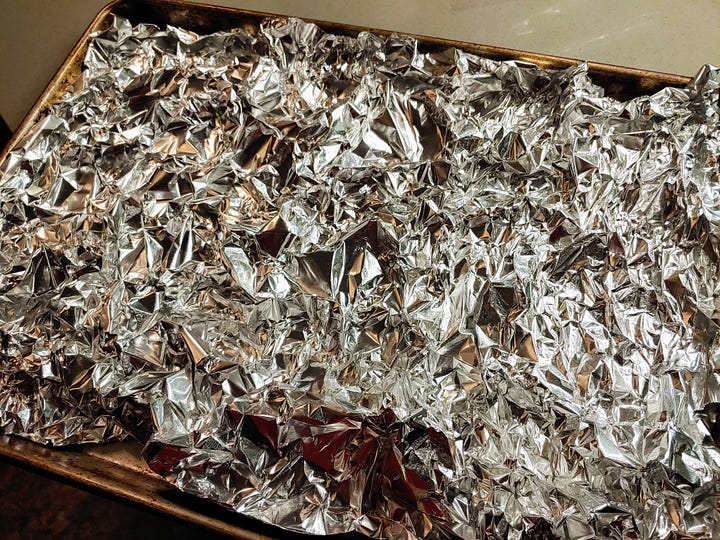

Note: Freshly-Toasted Bread Crumbs
Two slices of regular sandwich bread should be plenty for the 1 cup needed here; any extra crumbs can be saved for another use. Tear each bread slice into 5 or 6 pieces; I don’t bother removing the crusts, seems a waste unless you have another use for them. Pulse the bread in a food processor to form crumbs; avoid over-processing, I like for there to still be a few slightly bigger pieces among the fine crumbs. Where fresh crumbs are called for, they can be used as is. For this recipe, though, they’ll be toasted in the oven a bit for the best texture as an oyster topping.
Put the fresh bread crumbs in a small baking pan, like a cake pan or pie pan. Lightly toast them in a 400 F oven, 3 to 5 minutes, stirring every minute or so. You’re going for just very lightly browned and gently dried, they’ll brown more on the oysters. Set aside to cool.


